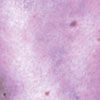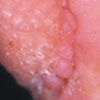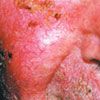- CDC
- Heart Failure
- Cardiovascular Clinical Consult
- Adult Immunization
- Hepatic Disease
- Rare Disorders
- Pediatric Immunization
- Implementing The Topcon Ocular Telehealth Platform
- Weight Management
- Screening
- Monkeypox
- Guidelines
- Men's Health
- Psychiatry
- Allergy
- Nutrition
- Women's Health
- Cardiology
- Substance Use
- Pediatrics
- Kidney Disease
- Genetics
- Complimentary & Alternative Medicine
- Dermatology
- Endocrinology
- Oral Medicine
- Otorhinolaryngologic Diseases
- Pain
- Gastrointestinal Disorders
- Geriatrics
- Infection
- Musculoskeletal Disorders
- Obesity
- Rheumatology
- Technology
- Cancer
- Nephrology
- Anemia
- Neurology
- Pulmonology
Antimalarial-Induced Melanosis and Rectal Bleeding: Complication of Radiation Therapy
Self-Test Your Diagnostic Acumen

Case 1
Patches of Discoloration on the Shins
A 42-year-old woman has been taking hydroxychloroquine, 200 mg/d, for systemic lupus erythematosus for 6 months. Recently, she noticed areas of gray-brown hyperpigmentation on her shins. Are the skin changes drug-related-or is this a manifestation of the underlying disease?
(Answer on next page.)

Case 1: Antimalarial-induced melanosis
A biopsy of material from a site of discoloration demonstrated hemosiderin around the capillaries and dermal melanin. Antimalarial-induced melanosis was diagnosed. The hydroxychloroquine was discontinued, and the hyperpigmentation cleared completely within a few months. Chloroquine, 250 mg/d, was initiated without adverse effect.
A bluish gray to black hyperpigmentation may occur in 10% to 30% of patients who have taken any antimalarial agent for 4 months or longer. The most commonly affected areas are the face, nape of the neck, palate, nail beds, and along the edge of the shin bones. Discoloration of the skin disappears when the culprit drug is stopped.
(Case and photograph courtesy of Reynold C. Wong, MD.)

Case 2
Rectal Bleeding
Painless rectal bleeding developed in a 71-year-old man who had undergone external beam radiation for prostate cancer 1 year earlier. The endoscopic findings show numerous mucosal telangiectases in the distal rectum near the dentate line. Friability and mucosal pallor are visible as well.

Histological examination reveals fibrosis within the connective tissue and endarteritis of the arterioles. Are these findings common sequelae of radiation therapy-and how would you treat?
(Answer on next page.)

Case 2: Radiation proctitis
This patient's symptoms resulted from radiation proctitis, which was treated with 2 courses of laser electrofulguration. Radiation injury of the GI tract is a well-documented complication of radiation therapy to the pelvis.1 The acute reaction often manifests with diarrhea, nausea, and tenesmus. Late or chronic complications occur months to years after treatment; affected patients present with painless rectal bleeding.
Initial management of both acute and late complications may consist of dietary measures, including a low-fiber diet; use of bulking agents, such as over-the-counter preparations that contain psyllium; and corticosteroid enemas. If these fail, more aggressive therapies, such as topical formalin or 1 to 3 laser treatments delivered via endoscope, may be helpful.

Topical formalin was not beneficial in this patient; however, 2 laser treatments successfully resolved his symptoms.
REFERENCE:1. Brown FA. Gastrointestinal complications associated with radiation therapy-characteristic, confusing, or compounded. Am J Dig Dis. 1962;7:1006-1025. (Case and images courtesy of Virendra Parikh, MD.)

Case 3
Papules on a Great Toe
During a routine examination, a linear array of papules is noted on a 58-year-old man's great toe. The patient tells of having received medical care for an injury to his toe during the Vietnam War.
What is this lesion, and what is its likely cause?
(Answer on next page.)

Case 3: Suture granuloma
Granulomas are chronic proliferative reactions to foreign bodies and infections; they may also occur idiopathically. Histopathological examination reveals lymphocytes, monocytes, epithelioid cells, macrophages, and/or multinucleated giant cells. This common subtype of a foreign-body granuloma is known as a suture granuloma. If necessary, suture granulomas may be removed by surgical excision to relieve pain and discomfort.
(Case and photograph courtesy of Charles E. Crutchfield III, MD.)

Case 4
Painful Rash
A 62-year-old man has had a severe, painful rash on his face for 2 weeks. The rash appeared 2 days after the patient started using 5% fluorouracil cream for actinic keratoses.
Is this reaction to be expected in patients who take this medication?
(Answer on next page.)

Case 4: Severe reaction to 5-fluorouracil
An irritant reaction to topical 5-fluorouracil is expected; however, this patient's inflammatory response was much more severe than is usual. The cream was discontinued; a few-day regimen of topical triamcinolone was prescribed. Thereafter, a 2.5% hydrocortisone ointment was used for 3 weeks. Warm, damp compresses applied to the face eased the pain.
The patient's rash resolved completely after 3 weeks of mild corticosteroid therapy. He was cautioned to avoid 5-fluorouracil in the future or, if necessary, to use it sparingly.
(Case and photograph courtesy of Raymond T. Kuwahara, MD.)
